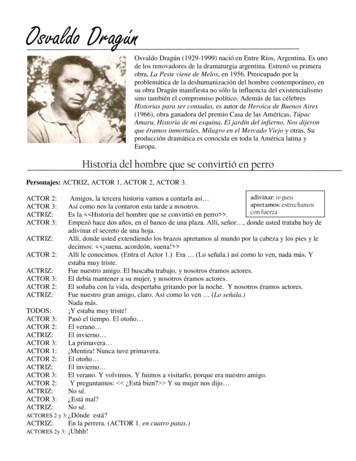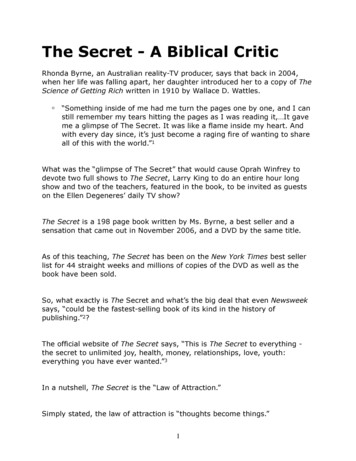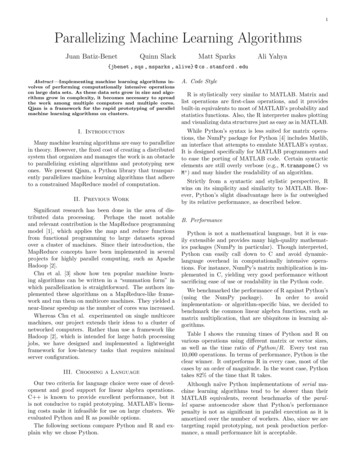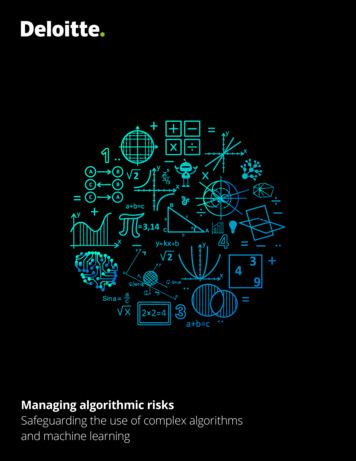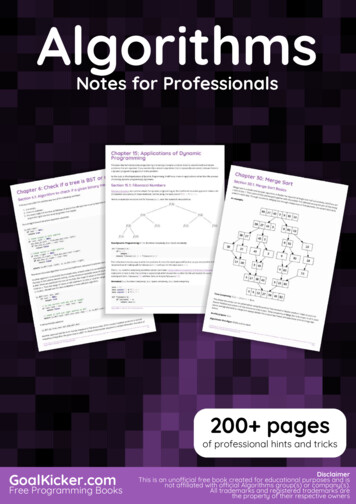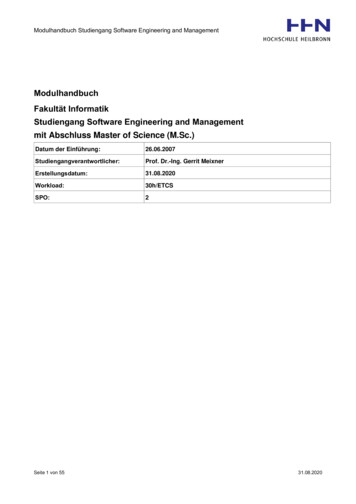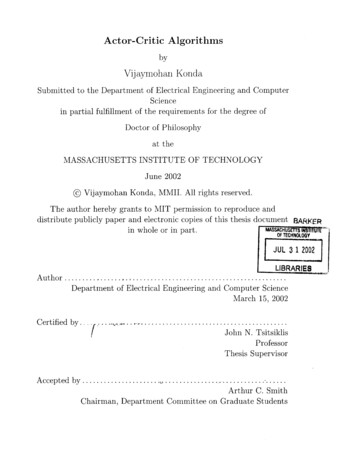
Transcription
Actor-Critic AlgorithmsbyVijaymohan KondaSubmitted to the Department of Electrical Engineering and ComputerSciencein partial fulfillment of the requirements for the degree ofDoctor of Philosophyat theMASSACHUSETTS INSTITUTE OF TECHNOLOGYJune 2002 Vijaymohan Konda, MMII. All rights reserved.The author hereby grants to MIT permission to reproduce anddistribute publicly paper and electronic copies of this thesis c ocument BARKERMASSACHUSETStNTs1IIUin whole or in part.OF TECHNOLOGYJUL 3 12002LIBRARIESA uthor . . .Department of Electrical Engineering and Computer ScienceMarch 15, 2002Certified by.F.- -.John N. TsitsiklisProfessorThesis Supervisor. .Arthur C. SmithChairman, Department Committee on Graduate StudentsAccepted by .
Actor-Critic AlgorithmsbyVijaymohan KondaSubmitted to the Department of Electrical Engineering and Computer Scienceon March 15, 2002, in partial fulfillment of therequirements for the degree ofDoctor of PhilosophyAbstractMany complex decision making problems like scheduling in manufacturing systems,portfolio management in finance, admission control in communication networks etc.,with clear and precise objectives, can be formulated as stochastic dynamic programming problems in which the objective of decision making is to maximize a single"overall" reward. In these formulations, finding an optimal decision policy involvescomputing a certain "value function" which assigns to each state the optimal rewardone would obtain if the system was started from that state. This function then naturally prescribes the optimal policy, which is to take decisions that drive the systemto states with maximum value.For many practical problems, the computation of the exact value function is intractable, analytically and numerically, due to the enormous size of the state space.Therefore one has to resort to one of the following approximation methods to finda good sub-optimal policy : (1) Approximate the value function. (2) Restrict thesearch for a good policy to a smaller family of policies.In this thesis, we propose and study actor-critic algorithms which combine theabove two approaches with simulation to find the best policy among a parameterizedclass of policies. Actor-critic algorithms have two learning units: an actor and acritic. An actor is a decision maker with a tunable parameter. A critic is a functionapproximator. The critic tries to approximate the value function of the policy usedby the actor, and the actor in turn tries to improve its policy based on the currentapproximation provided by the critic. Furthermore, the critic evolves on a fastertime-scale than the actor.We propose several variants of actor-critic algorithms. In all the variants, thecritic uses Temporal Difference (TD) learning with linear function approximation.Some of the variants are inspired by a new geometric interpretation of the formulafor the gradient of the overall reward with respect to the actor parameters. Thisinterpretation suggests a natural set of basis functions for the critic, determined bythe family of policies parameterized by the actor's parameters. We concentrate onthe average expected reward criterion but we also show how the algorithms can bemodified for other objective criteria. We prove convergence of the algorithms forproblems with general (finite, countable, or continuous) state and decision spaces.To compute the rate of convergence (ROC) of our algorithms, we develop a general theory of the ROC of two-time-scale algorithms and we apply it to study ouralgorithms. In the process, we study the ROC of TD learning and compare it withrelated methods such as Least Squares TD (LSTD). We study the effect of the basis2
functions used for linear function approximation on the ROC of TD. We also showthat the ROC of actor-critic algorithms does not depend on the actual basis functionsused in the critic but depends only on the subspace spanned by them and study thisdependence.Finally, we compare the performance of our algorithms with other algorithmsthat optimize over a parameterized family of policies. We show that when only the"natural" basis functions are used for the critic, the rate of convergence of the actorcritic algorithms is the same as that of certain stochastic gradient descent algorithms.,However, with appropriate additional basis functions for the critic, we show that ouralgorithms outperform the existing ones in terms of ROC.Thesis Supervisor: John N. TsitsiklisTitle: Professor3
AcknowledgmentsI gratefully acknowledge the constant support and encouragement of my thesis advisorProfessor John Tsitsiklis. His extraordinary patience, and his approach to research,writing, teaching, and mentoring has been a great source of inspiration. My association with him for the past three years has been one great learning experience.I am also indebted to Professor Sanjoy Mitter for his support and encouragementduring the most difficult part of my life. I would like to thank Professor Mitter forhis interest in my studies and career, and his advice. Professor Mitter and ProfessorBertsekas served as thesis readers. I would like to thank Professor Bertsekas for hisencouragement and advice.My master's thesis advisor Professor Vivek Borkar introduced me to the field ofNeuro-Dynamic programming/Reinforcement learning. My understanding of probability theory and stochastic control was very much influenced by our interaction.My numerous discussions with Anand Ganti, Anant Sahai, Sekhar Tatikonda,Maurice Chu, Constantine Caramanis and Ramesh Johari have improved my understanding of various research areas.Finally, I thank my parents for their unconditional support and encouragement.They have made great sacrifices to promote my career. I would also like to thankmy wife Manjula, without her support and understanding this thesis would not havebeen completed. The innocent smile of our newborn son Vinay helped me withstandthe stress of thesis writing.This research was partially supported by the National Science Foundation undercontract ECS-9873451 and by the AFOSR under contract F49620-99-1-0320.4
Contents1.3.2 Rate of Convergence (ROC) .1.3.3 Stochastic Approximation . . . .Contributions and Outline of the Thesis771013161616172Optimization over a Family of Policies2.1 Markov Decision Processes . . . . . . . . . . . . . . . . .2.2 Problem Formulation2.3 The Gradient of the Average Reward .2.4 The Gradient of the Discounted Reward2.5 The Gradient of the Total Reward . .2.6 Closing Remarks . . . . . . . . . . . . .202022263537393Linear Stochastic Approximation Driven by Slowly Varying MarkovChains3.1 Overview of the Proof. .3.2 Proof of Boundedness.3.2.1 Bounds on the Perturbation Noise . . . . . . . . . . . . . . . .3.2.2 Proof of Boundedness . . . . . . . . . . . . . . . . . . . . . . .3.3 Proof of Theorem 3.2 . . . . . . . . . . . . . . . . . . . . . . . . . . .3.4 Closing Rem arks . . . . . . . . . . . . . . . . . . . . . . . . . . . . .414345465254551Introduction1.1 Control of Complex Systems . . . . . . .1.2 Previous Work . . . . . . . . . . . . . .1.3 Problem Description . . . . . . . . . . .1.3.1 Actor-Critic Algorithms.1.44 The Critic4.1 Average Reward . . . . . . . . . .4.1.1 Convergence Results . . .4.2 Discounted Reward . . . . . . . .4.3 Total Reward . . . . . . . . . . .4.4 Convergence Analysis of the Critic4.4.1 TD(1) Critic . . . . . . . .4.4.2 TD(A) Critic, A 1.4.5 Closing Remarks . . . . . . . . .5.575960636566677276
5Actor-Critic Algorithms5.1 Actor without Eligibility Traces . . . . . . . . . . . . . . . . . . . . .7879Convergence Analysis . . . . . . . . . . . . . . . . . . . . . . .855.1.15.25.36Rate of Convergence of Temporal Difference Learning9.9192Recursive TD.6.2Bounds on the Variance of TD . . . . . . . . . . . . . . . . . .6.1.1Rate of convergence of LSTD . . . . . . . . . . . . . . . . . . . . . .96986.2.1Effect of Features . . . . . . . . . . . . . . . . . . . . . . . . .1006.2.2Bounds on the Intrinsic Variance of TD . . . . . . . . . . . . .102Closing Remarks . . . . . . . . . . . . . . . . . . . . . . . . . . . . .103Rate of Convergence of two-time-scale stochastic approximation7.1 Introduction . . . . . . . . . . . . . . . . . . . . . . . . . . . . . . . .1041047.27.3Linear Iterations . . . . . . . . . . . . . . . . . . . . . . . . . . . . .Separation of Time-scales . . . . . . . . . . . . . . . . . . . . . . . .1071147.4Single Time-scale vs. Two Time-scales . . . . . . . . . . . . . . . . .1157.57.67.7Asymptotic Normality . . . . . . . . . . . . . . . . . . . . . . . . . .Nonlinear Iterations . . . . . . . . . . . . . . . . . . . . . . . . . . . .Auxiliary Results . . . . . . . . . . . . . . . . . . . . . . . . . . . . .1161211237.7.1Verification of Eq. (7.19) . . . . . . . . . . . . . . . . . . . . .1237.7.27.7.37.7.4Convergence of the Recursion (7.20) . . . . . . . . . . . . . . .Linear Matrix Iterations . . . . . . . . . . . . . . . . . . . . .Convergence of Some Series . . . . . . . . . . . . . . . . . . .124125126Closing Remarks . . . . . . . . . . . . . . . . . . . . . . . . . . . . .1277.88. . .878787896.16.37Actor with Eligibility5.2.1A 1 . . . . .5. .2 A 1 . . . . .Closing Remarks . .Traces . . . . . . . . . . . . . . . . . . . . . . . . . . . . . . . . . . . . . . . . . . . . . . . . . . . . . . . . . . . . . . . . . . . . . . . . . . . . . . . . . . . . . . . . . . . . . . . . . . . . .Rate of convergence of Actor-Critic Algorithms1298.18.2Actor-only Methods . . . . . . . . . . . . . . . . . . . . . . . . . . . .Actor-Critic Methods . . . . . . . . . . . . . . . . . . . . . . . . . . .1291318.3Numerical Example . . . . . . . . . . . . . . . . . . . . . . . . . . . .1338.48.3.1 Actor-only Methods . . . . . . . . . . . . . . . . . . . . . . .8.3.2 Actor-Critic Method . . . . . . . . . . . . . . . . . . . . . . .Closing Remarks . . . . . . . . . . . . . . . . . . . . . . . . . . . . .134137140141Summary and Future Work143References6
Chapter 1IntroductionActor-Critic algorithms (Barto et al., 1983) originated in the Artificial Intelligence(AI) literature in the context of Reinforcement Learning (RL). In an RL task, an agentlearns to make "correct" decisions in an uncertain environment. Unlike supervisedlearning in which the agent is given examples of "correct" behavior, an RL agenthas to work with much less feedback as it is given only rewards (or penalties) for itsdecisions. Moreover, the decision making consists of several stages and the rewardmay be obtained either at the end or at each stage of the decision making process.The main difficulty with such problems is that of "temporal credit assignment" whichis to rank the decisions based on the overall reward when only the immediate rewardsat each stage are available.Some of the methods of RL were in part inspired by studies of animal learning andhence were heuristic and ad hoc. Nevertheless, some of them have been systematizedby establishing their connections with dynamic'programing and stochastic approximation. The original purpose of RL research was two-fold. On one hand, the goalwas to understand the learning behavior of animals and on the other, to apply thisunderstanding to solve large and complex decision making (or control) problems. Inthis thesis, the focus is only on control or decision making in large systems and onthe development of learning methods with good mathematical foundations.The outline of this chapter is as follows. In the next section, various issues thatarise in management and control of complex systems and a broad overview of theapproaches to tackle them are discussed. Then, a survey of the relevant literatureis presented. The third section of this chapter introduces actor-critic algorithms anddiscusses various open problems. The final two sections of this chapter describe thecontributions and the outline of the thesis.1.1Control of Complex SystemsAlthough "complex systems" are difficult to characterize precisely, these systems aretypically uncertain, distributed, and asynchronous. Scheduling in manufacturing systems, admission control in communication networks, admission and power controlin wireless networks, inventory control in supply chains, etc., are some examples of7
control problems related to complex systems. The following are some salient featuresof such control problems :1. The total information about the state of the system (which is seldom available)relevant to the decision making process, is high-dimensional. In control theoreticterms, this translates to a large number of states (in the discrete case) or a largedimension of the state space (in the continuous case). Therefore a realisticcontrol policy can only use a small number (compared to the dimension of thestate space) of features extracted from the state information. Furthermore, thechoice of these features (also called feature extraction) is a part of the controldesign, unlike in the case of traditional partially observed control problems.2. Models for such large and complex systems are difficult and costly to construct.Even when such models are available, it is not easy to solve correspondingthe control problems as they are intractable. Therefore, one has to resort tosimulation to understand the dynamics and design a control policy.3. Such problems cannot be solved by general purpose methods due to their inherent computational complexity and the size of underlying systems. Insteadone needs methods tuned to specific systems. This in turn requires engineeringinsight, intuition, experimentation and analysis.The types of problems we have mentioned above can often be formulated as optimalcontrol problems in which the objective is to maximize a single "overall" reward overall policies. Many of the simplified versions of such problems have been very wellstudied under the umbrella of Dynamic Programming (DP) (Bertsekas, 1995b), andmany impressive results on the existence and structure of the optimal policies havebeen obtained.The key concept in DP is that of a value function. The value function associatedwith a particular policy assigns to each state the overall reward one would obtain ifthe system was started from that state and the given policy was followed to makethe decisions. Finding an optimal decision policy using DP involves computing theoptimal value function (or simply the value function) which satisfies a nonlinear equation called the Bellman or the DP equation. This function then naturally prescribesan optimal policy, which is to take decisions that drive the system to states withmaximum value. However, the classical DP computational tools are often inadequatefor the following reason.The amount of computational resources (in particular, space) required for classical dynamic programming methods is at least proportional to (if not polynomial orexponential in) the size of the state space. The number of states (or the dimensionof the state space in continuous case) in many practical problems is so high that itprohibits the use of the classical methods. This has been a major drawback of computational dynamic programming and has been named the "Curse of Dimensionality"by Bellman.Due to the inadequacy of DP tools, the approach to control of complex systemshas mainly been heuristic and ad hoc. In an attempt to bridge the gap between8
the existing theory of DP and the practice of control design for large systems a newfield of research has emerged. In addition to developing new methods based on DPand simulation, this research laid foundations for many existing RL methods anddemarcated the science and the art in these methods. The thesis contributes tothis field by formalizing actor-critic algorithms and providing an analysis of theirconvergence and rate of convergence.There are at least three different approaches to handle the difficulties previouslymentioned .Model approximationOne approach is to approximate a complex system by asimpler tractable model and apply an optimal policy, designed using DP, for thesimpler model to the complex system. Taking this one step further, one can start witha class of simple tractable models and then determine, through some identificationprocedure, the best approximation (among this class) for the complex system.Value function approximation The second approach is to approximate the optimal value function for the control problem. Often, the "form" of this function canbe guessed to a certain extent in spite of the complexity of the system. For example,one might guess that the solution is monotonic or concave or polynomial in the statevariables. Then, one can either hand code a value function or select the "best" approximation from a class of functions with these properties. Once an approximationto the value function is obtained, it can then be used to generate controls as if thiswere the exact value function.Policy approximationFinally, instead of approximating the model or the valuefunction, a good policy can be directly selected from a set of candidate policies,arrived at through various considerations like convenience of implementation andprior insights into the structure of an optimal policy. A straightforward strategy toselection of good policies, that is feasible only with finite and reasonably small setof candidate policies, is to evaluate the performance, in terms of overall reward, ofeach candidate policy. A more widely applicable approach is possible when the set ofpolicies can be parameterized by a vector of reasonably small dimension. In this case,the selection of a good policy can be thought of as an optimization over the parameterspace, where the reward of a parameter vector is the overall reward obtained by usingthe corresponding policy. Since the reward of a parameter can only be determinedby simulation, stochastic optimization methods are used to determine good policyparameters. The candidate policies are often chosen to be randomized to incorporatesufficient exploration of decisions and also to make the overall reward a differentiablefunction of the policy parameters. In cases where the implementation of a randomizedpolicy is not appropriate, the randomized policy obtained by this approach can be"rounded off" to its "nearest" deterministic policy.While many permutations and combinations of the above three approaches arepossible, in this thesis, we are primarily concerned with methods called actor-criticalgorithms which combine policy approximation with value function approximation.9
The aim of this thesis is to show that these methods have significant advantages overtheir counterparts which are based solely on policy approximation.Though value function approximation methods are adequate for many applications, there are other important applications where the actor-critic or policy approximation methods might be more desirable than value function methods:" In problems with complicated decision spaces, given a value function, the computation of the "optimal" decisions implied by the value function may be nontrivial because it involves an optimization of the value function over the decisionspace. In such problems, storing an explicit representation of a policy may beadvantageous compared to an implicit representation based on a value function." In some problems, the policy implied by a value function approximation may notbe implementable, e.g., due to the distributed nature of the state information.In these cases, it is more appropriate to optimize over an "implementable"family of policies than to approximate value function.The general structure of actor-critic algorithms is illustrated by Figure 1-1. As thename suggests, actor-critic algorithms have two learning units, an actor and a critic,interacting with each other and with the system during the course of the algorithm.The actor has a tunable parameter vector that parameterizes a set of policies and atany given time instant, it generates a control using the policy associated with its current parameter value. The actor updates its parameter vector at each time step usingits observations of the system and the information obtained from the critic. Similarly,at each time step, the critic updates its approximation of the value function corresponding to the current policy of the actor. Note the similarity between Actor-Criticmethods and policy iteration (Puterman, 1994) in dynamic programming. While thevalue function approximation methods can be thought of as simulation-based counterpart of value iteration, actor-critic methods can be thought of as counterparts ofpolicy iteration.1.2Previous WorkAdaptive control methods similar to actor-critic algorithms were first proposed in(Witten, 1977). The actor-critic architecture as described by Figure 1-1 was intro-duced and applied to the pole-balancing problem (Michie & Chambers, 1968) in theseminal work of (Barto et al., 1983).Later, these methods were extensively stud-ied in (Sutton, 1984; Anderson, 1986). A key step was taken by (Sutton, 1988) byseparating the critic and treating it as a general method for policy evaluation (approximating the value function corresponding to a particular policy). This policyevaluation method was named temporal difference learning. Finally, (Watkins, 1989)developed a method called Q-learning for approximating the optimal value function.This separation of policy evaluation methods and the advent of Q-learning led to ashift of focus of RL research from actor-critic schemes to those based on value function approximation. Another reason for this shift of focus was that the convergence10
rdSystemFigure 1-1: Actor-Critic Algorithms11
of value function approximation methods was better understood than that of theactor-critic schemes.The convergence of Q-learning and temporal difference learning with lookup-tablerepresentations and state aggregation was established in (Tsitsiklis, 1994; Jaakolaet al., 1994; Abounadi et al., 2001; Abounadi et al., 1998). Similarly, the convergenceof temporal difference learning with linear function approximation was established in(Tsitsiklis & Van Roy, 1997; Tsitsiklis & Van Roy, 1999a). While the (optimal) valuefunction approximation methods led to some impressive empirical results, they lackedsatisfactory convergence guarantees except for some special function approximationschemes (Tsitsiklis & Van Roy, 1996; Ormoneit & Sen, 2000; Ormoneit & Glynn,2001) and optimal stopping problems (Tsitsiklis & Van Roy, 1999b). For a textbookaccount of RL and its history see (Bertsekas & Tsitsiklis, 1996; Sutton & Barto,1998).Meanwhile, another approach based only on policy approximation was exploredby (Glynn, 1986; Glynn, 1987) and later independently rediscovered by (Williams,1992). The convergence analysis of these methods was carried out in (Marbach, 1998;Marbach & Tsitsiklis, 2001; Baxter & Barlett, 1999). In contrast to value functionapproximation, policy approximation schemes have good convergence guarantees butsuffer from slow convergence.Since their introduction in (Barto et al., 1983), actor-critic algorithms have eludedsatisfactory convergence analysis. Due to this lack of understanding and poor performance of policy approximation methods, value function based methods receivedmuch of the attention even though the actor-critic architecture predated value function approximation methods. In (Williams & Baird, 1990), an attempt was made tounderstand these algorithms through the analysis of asynchronous versions of policyiteration. A heuristic analysis of a special case of actor-critic algorithms was presentedin (Kimura & Kobayashi, 1998).The two main reasons the actor-critic methods are difficult to analyze are thefollowing." First, for the criticshould observe, forunder the influencethe actor's decisionto provide an accurate evaluation of the actor's policy, itan indefinite amount of time, the behavior of the systemof the actor's decisions. However, in actor-critic algorithms,policy changes continuously." Second, there can be large approximation errors, due to function approximation,in the critic's evaluation of the policy and it is not clear whether a policy canbe improved even with an erroneous approximation of a value function.In (Konda, 1997; Konda & Borkar, 1999), the first issue was circumvented by usingdifferent step-sizes for the actor and the critic: the critic uses infinitely large stepsizes relative to the actor. Therefore, the actor looks stationary to the critic and thecritic behaves as if it can evaluate actor's policy instantly. However, the algorithms in(Konda, 1997; Konda & Borkar, 1999) use look-up table representations and thereforedo not address the second issue.12
The following section discusses these issues in more detail and describes the contribution of the thesis towards the understanding of actor-critic algorithms.1.3Problem DescriptionTo make the discussion more concrete and to put the contributions of the thesis inperspective, a semi-formal discussion of some preliminaries and actor-critic algorithmsis presented in this section. To keep the discussion simple, consider a finite state,discrete-time stochastic system, with state space X, that evolves under the influenceof a decision making agent as follows:* At each time instant k, the agent chooses a decision Uk, from a finite set ofchoices U, based on the current state of the system Xk.9The agent receives a reward g(Xk,Uk)for his decision at time k.9 The system moves to a new state Xk 1 according to transition probabilitiesp(Xk 11Xk, Uk) where for each state x and decision u, p(jIX, u) is a probabilitymass function on the state space X.A policy is a mapping M that assigns to each state x, a probability mass function ,u(-IX)on the decisions according to which the decisions are generated when the system is instate x. A special class of policies is the class of deterministic policies which can bethought of as functions p: X - U. For each policy p, the associated value functionV : X - R (corresponding to the total reward problem) is defined asCOV,(x) EE[g(Xk, Uk)IXo x],k Owhere E, denotes the expectation with respect to the probability distribution of theprocess {(Xk, Uk)} when the agent uses policy p to generate decisions. The optimalvalue function is defined byV(x) maxV,(x).For the value function to be finite for all policies, assume that there is an absorbing,reward-free, terminal state t which is hit with probability one from all starting states.A standard result in dynamic programming states that the optimal value function isthe unique solution of the DP equation (or the Bellman equation):V(cc) max[ (x, u) ZP(y IXU) V(Y)1Furthermore, deterministic policies p which take decisions that maximize the r.h.s inthe Bellman equation are optimal.13
Note that both the value function V and the probabilities p(ylx, u) are needed tocompute the optimal policy. However, for some systems, the transition probabilitiesmay be unavailable. For this reason, the concept of a Q-value function (also calledstate-decision value function) was introduced in (Watkins, 1989). The state-decisionvalue function Q, : X x U -* IR of a policy p is defined as00Qjx, u) E ,[9(Xk, Uk) Xox-, Uo U].k OIt is now easy to see that the optimal state-decision value functionQ(X,u) max Q,(x, u),satisfies a modified Bellman equationQ(x, ') g(x, u) 5p(yx, u) max Q(y, i)and a policy which takes decisions that maximize Q(x, u) is optimal.Some value function based methods learn an approximation Q of the optimalstate-decision value function using simulation. This learned approximation Q is usedto obtain an approximation to an optimal policy by settingp(x) arg maxQ(x, u).UThere are two problems with this approach. There are counterexamples showing thatthese methods may fail to converge. Furthermore, when they converge, there are noguarantees on the quality of the policies obtained using these methods (Bertsekas,1995a).In contrast, methods called temporal difference (TD) learning which approximatestate or state-decision value function for a particular policy p are well understood.These methods often use linear function approximation schemes. That is, they approximate the value function V by a linear combination of basis functions:1(x)i E()where the ri are tunable parameters and the q' are predetermined basis functions,often called features. Such methods are guaranteed to converge and are widely ap-plicable (Tsitsiklis & Van Roy, 1997).For example, TD methods can be used inthe policy evaluation step of policy iteration. Policy iteration is a classical DP algorithm used to compute an optimal policy. It starts with a deterministic policy /o andimproves it iteratively as follows:Policy EvaluationCompute the value function V,, of the current policy 1I.14
Policy ImprovementPLk (X)A new policy argmaxgk 1is obtained by[9(x u) p(yjx, u)V,&Y)jIt is well known, that if the policy evaluation is exact, the policy is strictly improved ineach iteration, unless the current policy is optimal. Therefore, this method convergesto an optimal policy after a finite number of iterations. When approximation methodssuch as TD are used in the policy evaluation step, the policy need not improve ineach iteration. However, it can be shown that in the limit, the algorithm performs arandom walk on a set of policies whose distance from optimality is at most linear inthe approximation error during the policy evaluation phase (Bertsekas & Tsitsiklis,1996).The oscillatory behavior of approximate policy iteration is due to the fact thatin the policy improvement step, the algorithm takes a large step in policy space,based only on an approximation. This, in turn, is due to the fact that the searchfor an optimal policy during policy iteration is
Many complex decision making problems like scheduling in manufacturing systems, portfolio management in finance, admission control in communication networks etc., . eral theory of the ROC of two-time-scale algorithms and we apply it to study our . critic algorithms is the same as that of certain stochastic gradient descent algorithms.,
